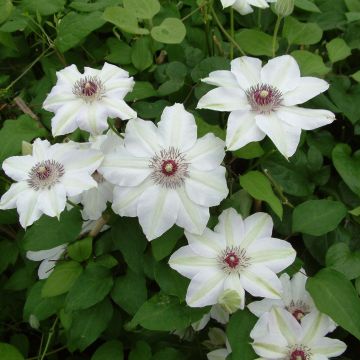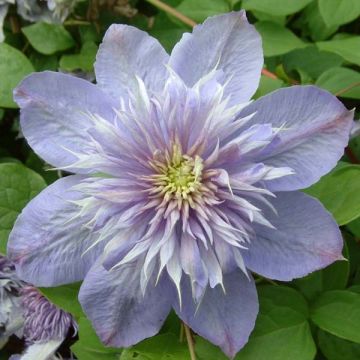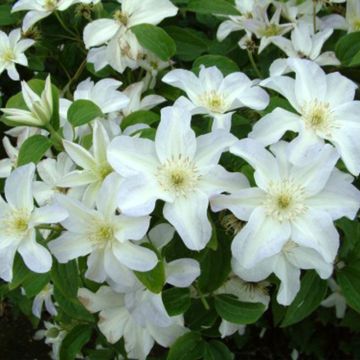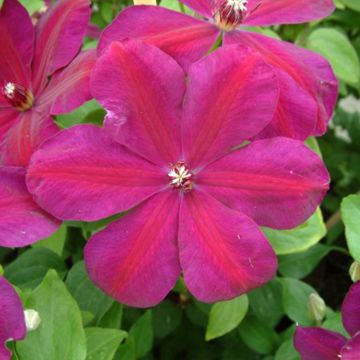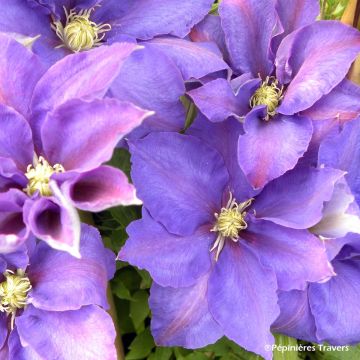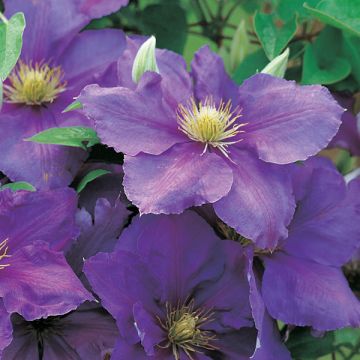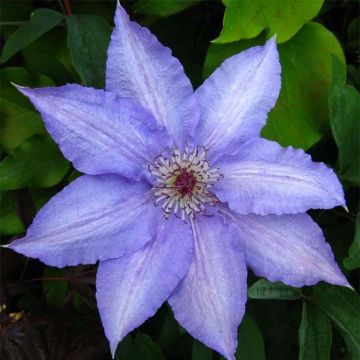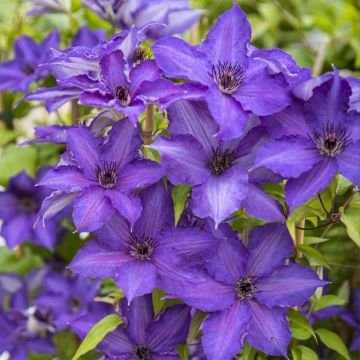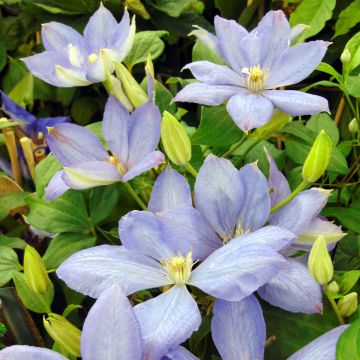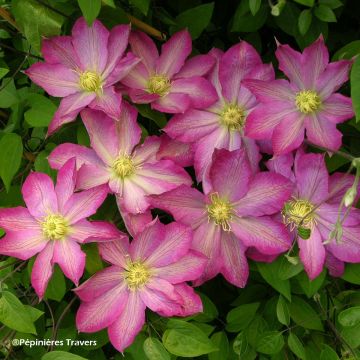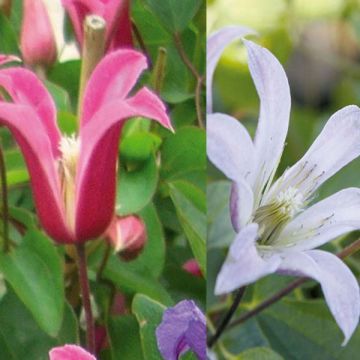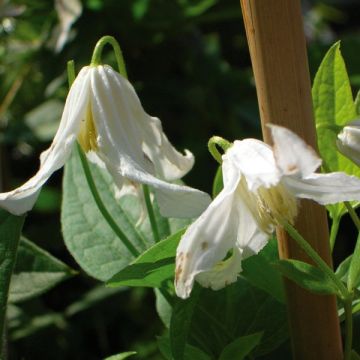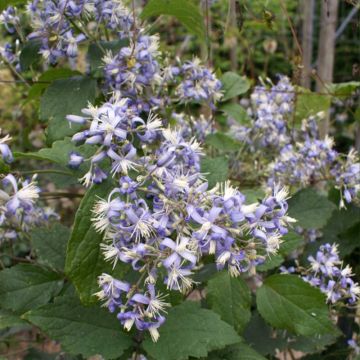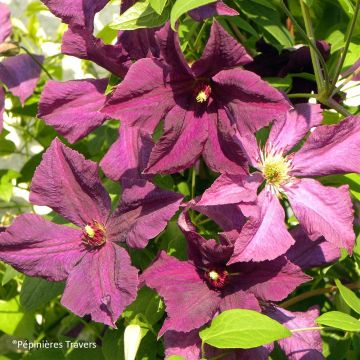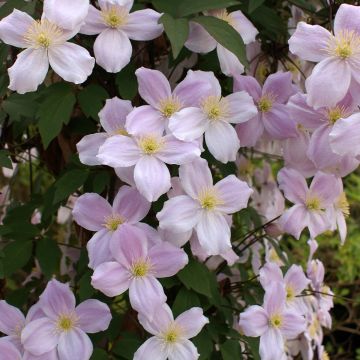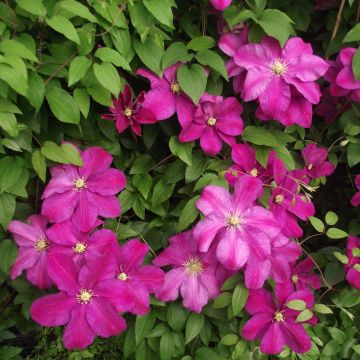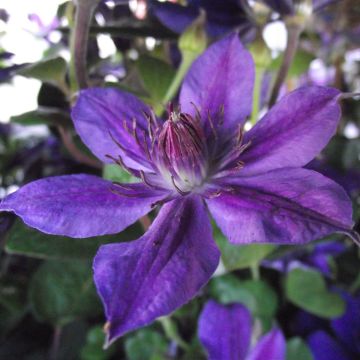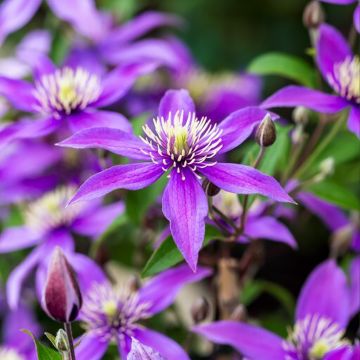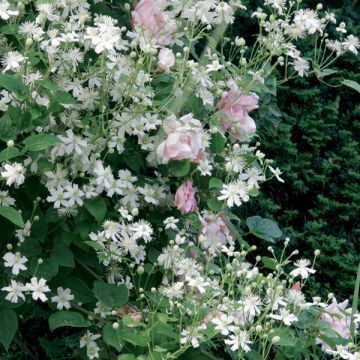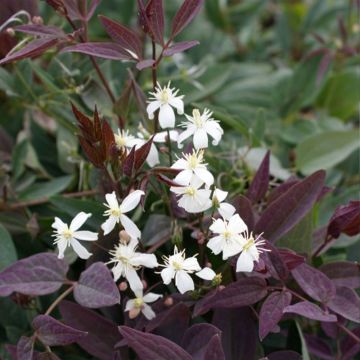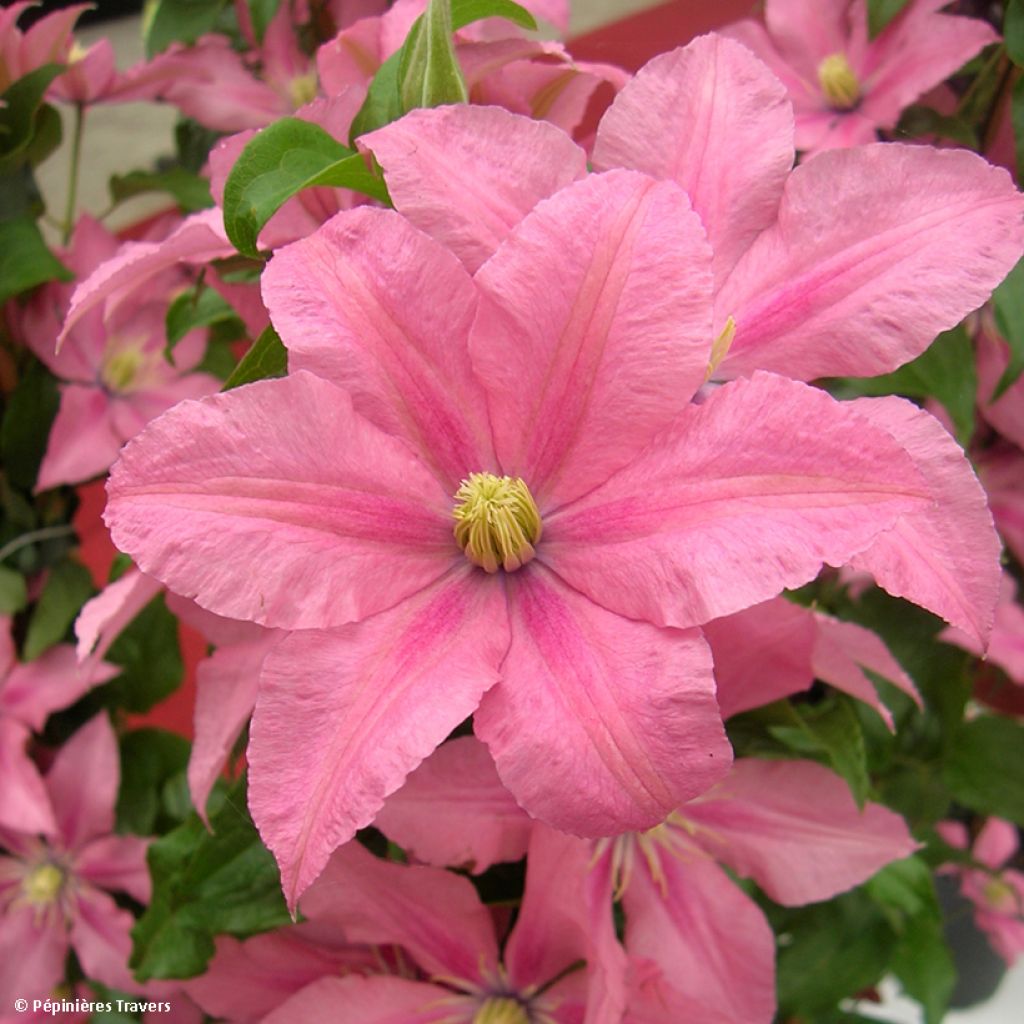

Clématite - Clematis Rosamunde
Clematis Rosamunde
Clematis patens Rosamunde
Early Large-flowered Clematis
This item cannot be shipped to the selected country
Delivery charge from €5.90
More information
Schedule delivery date,
and select date in basket
This plant carries a 6 months recovery warranty
More information
We guarantee the quality of our plants for a full growing cycle, and will replace at our expense any plant that fails to recover under normal climatic and planting conditions.
From €5.90 for pickup delivery and €6.90 for home delivery
Express home delivery from €8.90.
Does this plant fit my garden?
Set up your Plantfit profile →
Description
Clematis 'Rosamunde' is a charming variety which flowers twice, allowing you to enjoy its beautiful blooms for nearly the whole summer. From June onwards, large flowers in the shape of stars appear, a light pink tinged with salmon and highlighted by a dark pink stripe at the centre of each petal. The open corolla is adorned with a yellow stamen heart, which contrasts pleasantly with the pink. Its beautiful green foliage harmonises perfectly with the flowers, making this small climbing plant a gem for the garden. Its compact size means it can be planted in a pot to enhance a terrace or balcony.
Clematis is a member of the Ranunculaceae family, like Anemones, Trollius, Hellebores, and many other ornamental genera. With approximately 300 species, the genus Clematis includes numerous climbers, as well as some herbaceous perennials, such as Clematis stans. Clematis patens, from which 'Rosamunde' originates, is a woody clematis native to low-altitude forests in northern Japanese islands, described in 1836. It belongs to the group of Clematis that bloom twice. The first blooms appear in spring on the previous year's shoots, followed by a second flowering in late summer on the current year's growth. This characteristic explains its success since its introduction to Europe in the second half of the 19th century, where it has been extensively hybridized to produce numerous horticultural varieties.
Rosamunde is a cultivar that appeared on the market in the year 2000, created by the German breeder Willem Straver. This Clematis bears quite large, patens-type flowers (8 to 10 cm (3 to 4in)), first from June, and then again later in summer. This long flowering period is the main asset of this beautiful variety, with its open star-shaped flowers composed of 6 to 10 tepals (the term used for petals and sepals that are morphologically very similar in this plant). The pointed-tip tepals are a beautiful light pink with a hint of salmon and streaked in the middle with a dark pink stripe that runs from the centre to the edge. The corolla's centre is occupied by a cluster of yellow stamens, which adds to the romantic charm of the blooms. The deciduous tri palmate leaves are a lovely vibrant green, which perfectly complements the flower colour. This Clematis attaches itself to a support or host plant using modified petioles that form tendrils. With a rather fast growth rate (about 40 to 50 cm (16 to 20in) per year), it will reach 2 m (7ft) high with a width of 1 to 1.5 m (3 to 5ft). It can be grown in a container, making it ideal for decorating a small trellis on a terrace. If planted in the garden, it will thrive in any good garden soil that is sufficiently rich in organic matter, not too dry or too wet (and, in all cases, well-drained). It prefers full sun with some protection at the base (a flat tile works perfectly) and can tolerate dappled shade. It is quite hardy and can withstand temperatures as low as -23°C.
Rosamunde is a small Clematis with a romantic charm that will pair perfectly with roses when planted at the base of a fence. The Swany Groundcover Rose with its intricate white flowers that bloom at the same time would be an excellent choice. The Bobo Panicle Hydrangea, a very compact Hydrangea, would also make a great foreground with its large white flower heads turning pale pink towards the end of the season. To end on an equally romantic note, plant Marie Blue Ceanothus with its ethereal sky-blue summer blooms in your flower bed to create a contrast with Rosamunde's pink…
Report an error about the product description
Clematis Rosamunde in pictures
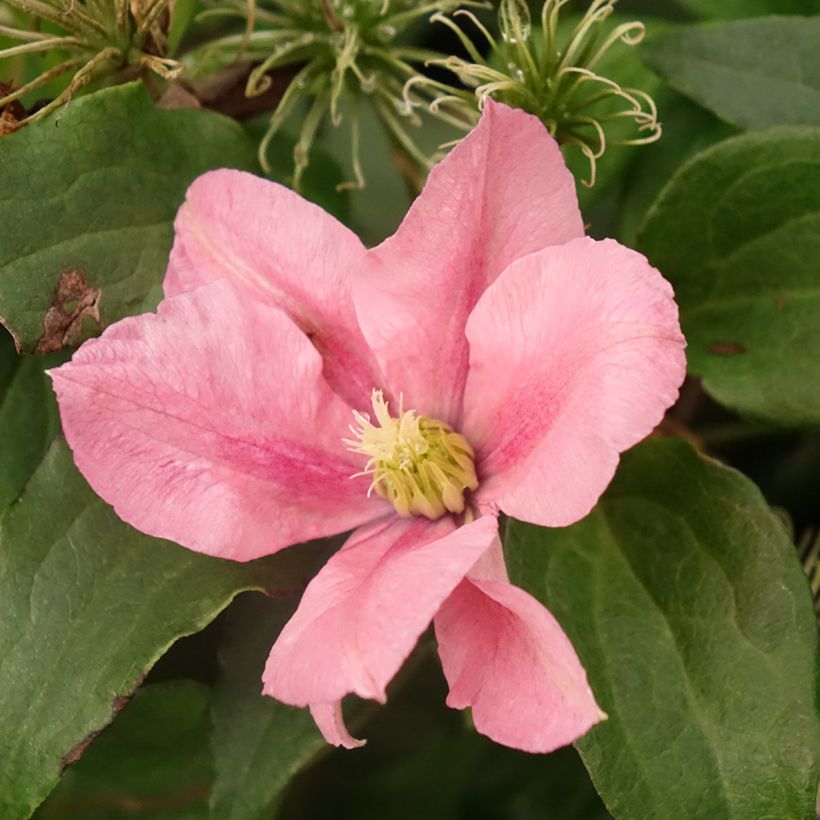

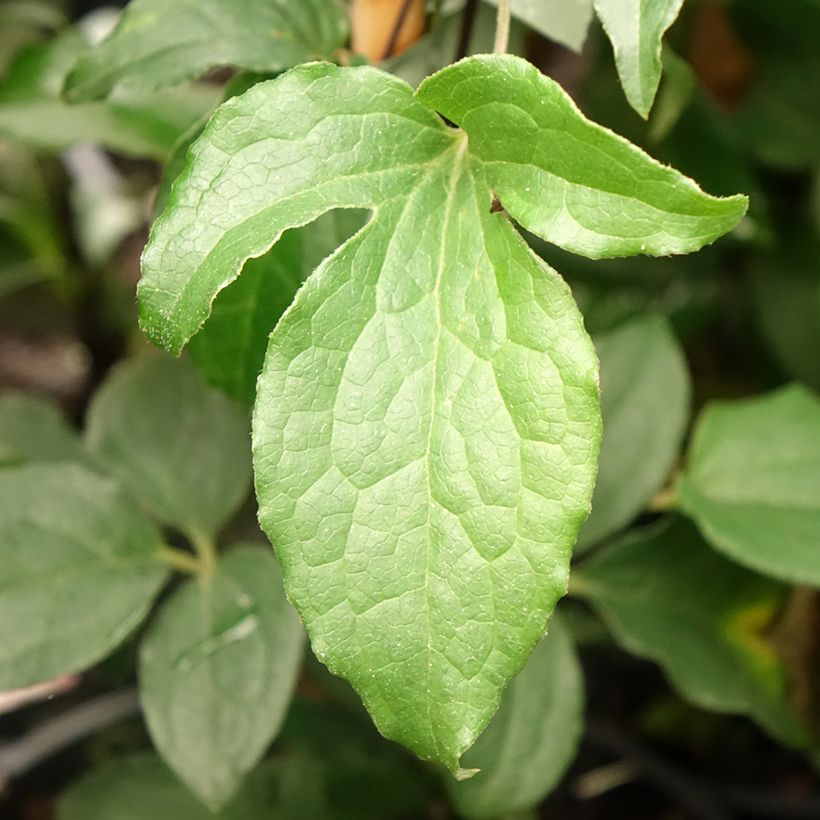

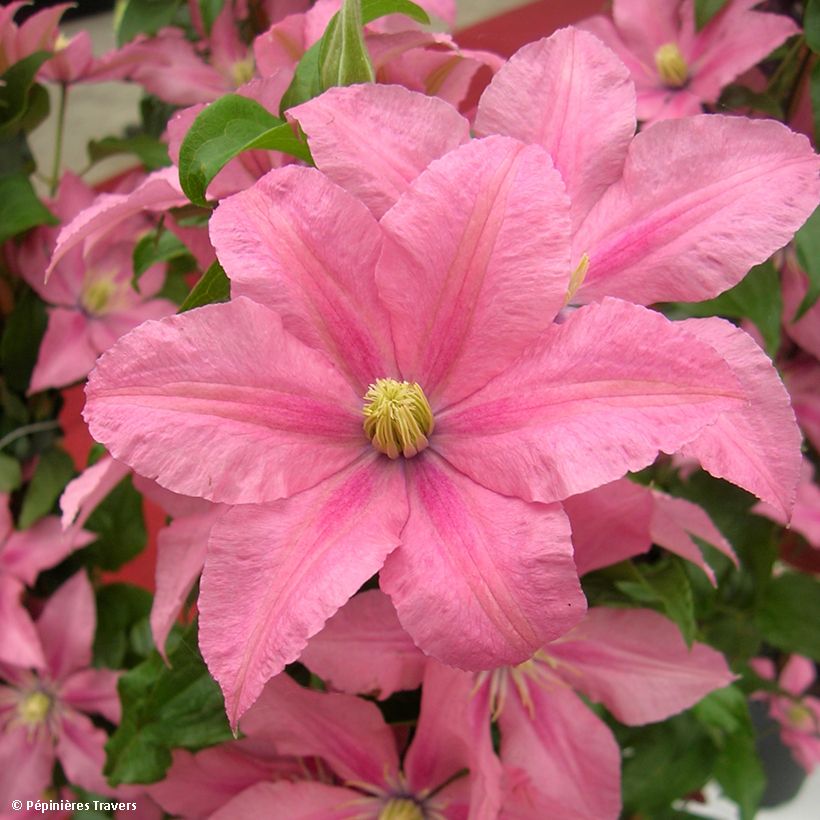

Plant habit
Flowering
Foliage
Botanical data
Clematis
patens
Rosamunde
Ranunculaceae
Early Large-flowered Clematis
Cultivar or hybrid
Other Clematis Patens
Planting and care
Preferably plant Clematis 'Rosamunde' in the sun, in a fertile, humus-rich, well-drained soil, shading the roots and the base of the stem (with a flat tile, for example). Herbaceous species prefer full sun and can wither in soil that is too wet.
Plant your clematis by covering the root ball with 3 cm (1in) of soil, in a soil worked to a depth of 20 cm (8in), lightened with good compost. Water regularly during the first few weeks, but be careful of stagnant water which can cause rotting at the collar. Cover the base of climbing clematis with a small mound of soil, reducing the risk of clematis wilt while promoting the emergence of vigorous new shoots from the crown. After planting, prune the stems of deciduous climbing clematis to around 30 cm (12in) from the base, above a healthy pair of buds. Mulch in February with garden compost or well-rotted manure, avoiding direct contact with the stems. Train the stems, without crushing them, until the plant grips for itself. Clematis also like to grow freely on neighbouring plants.
This variety flowers on the previous year's shoots in early summer, then on the current year's shoots in the second half of summer (hence its long flowering...). Prune it lightly in March (a simple cleaning is enough). After the spring flowering, cut back half of all the branches so that the clematis branches strongly, and forms new shoots for the second flowering during summer. You can prune the clematis down to 70 cm (28in) from the ground. Only prune severely to rejuvenate your clematis every 4 or 5 years. Clematis can be attacked by voles and slugs which can devour the stems. Aphids and greenhouse whiteflies are also potential pests.
Planting period
Intended location
Care
This item has not been reviewed yet - be the first to leave a review about it.
Clematis
Haven't found what you were looking for?
Hardiness is the lowest winter temperature a plant can endure without suffering serious damage or even dying. However, hardiness is affected by location (a sheltered area, such as a patio), protection (winter cover) and soil type (hardiness is improved by well-drained soil).

Photo Sharing Terms & Conditions
In order to encourage gardeners to interact and share their experiences, Promesse de fleurs offers various media enabling content to be uploaded onto its Site - in particular via the ‘Photo sharing’ module.
The User agrees to refrain from:
- Posting any content that is illegal, prejudicial, insulting, racist, inciteful to hatred, revisionist, contrary to public decency, that infringes on privacy or on the privacy rights of third parties, in particular the publicity rights of persons and goods, intellectual property rights, or the right to privacy.
- Submitting content on behalf of a third party;
- Impersonate the identity of a third party and/or publish any personal information about a third party;
In general, the User undertakes to refrain from any unethical behaviour.
All Content (in particular text, comments, files, images, photos, videos, creative works, etc.), which may be subject to property or intellectual property rights, image or other private rights, shall remain the property of the User, subject to the limited rights granted by the terms of the licence granted by Promesse de fleurs as stated below. Users are at liberty to publish or not to publish such Content on the Site, notably via the ‘Photo Sharing’ facility, and accept that this Content shall be made public and freely accessible, notably on the Internet.
Users further acknowledge, undertake to have ,and guarantee that they hold all necessary rights and permissions to publish such material on the Site, in particular with regard to the legislation in force pertaining to any privacy, property, intellectual property, image, or contractual rights, or rights of any other nature. By publishing such Content on the Site, Users acknowledge accepting full liability as publishers of the Content within the meaning of the law, and grant Promesse de fleurs, free of charge, an inclusive, worldwide licence for the said Content for the entire duration of its publication, including all reproduction, representation, up/downloading, displaying, performing, transmission, and storage rights.
Users also grant permission for their name to be linked to the Content and accept that this link may not always be made available.
By engaging in posting material, Users consent to their Content becoming automatically accessible on the Internet, in particular on other sites and/or blogs and/or web pages of the Promesse de fleurs site, including in particular social pages and the Promesse de fleurs catalogue.
Users may secure the removal of entrusted content free of charge by issuing a simple request via our contact form.
The flowering period indicated on our website applies to countries and regions located in USDA zone 8 (France, the United Kingdom, Ireland, the Netherlands, etc.)
It will vary according to where you live:
- In zones 9 to 10 (Italy, Spain, Greece, etc.), flowering will occur about 2 to 4 weeks earlier.
- In zones 6 to 7 (Germany, Poland, Slovenia, and lower mountainous regions), flowering will be delayed by 2 to 3 weeks.
- In zone 5 (Central Europe, Scandinavia), blooming will be delayed by 3 to 5 weeks.
In temperate climates, pruning of spring-flowering shrubs (forsythia, spireas, etc.) should be done just after flowering.
Pruning of summer-flowering shrubs (Indian Lilac, Perovskia, etc.) can be done in winter or spring.
In cold regions as well as with frost-sensitive plants, avoid pruning too early when severe frosts may still occur.
The planting period indicated on our website applies to countries and regions located in USDA zone 8 (France, United Kingdom, Ireland, Netherlands).
It will vary according to where you live:
- In Mediterranean zones (Marseille, Madrid, Milan, etc.), autumn and winter are the best planting periods.
- In continental zones (Strasbourg, Munich, Vienna, etc.), delay planting by 2 to 3 weeks in spring and bring it forward by 2 to 4 weeks in autumn.
- In mountainous regions (the Alps, Pyrenees, Carpathians, etc.), it is best to plant in late spring (May-June) or late summer (August-September).
The harvesting period indicated on our website applies to countries and regions in USDA zone 8 (France, England, Ireland, the Netherlands).
In colder areas (Scandinavia, Poland, Austria...) fruit and vegetable harvests are likely to be delayed by 3-4 weeks.
In warmer areas (Italy, Spain, Greece, etc.), harvesting will probably take place earlier, depending on weather conditions.
The sowing periods indicated on our website apply to countries and regions within USDA Zone 8 (France, UK, Ireland, Netherlands).
In colder areas (Scandinavia, Poland, Austria...), delay any outdoor sowing by 3-4 weeks, or sow under glass.
In warmer climes (Italy, Spain, Greece, etc.), bring outdoor sowing forward by a few weeks.

































